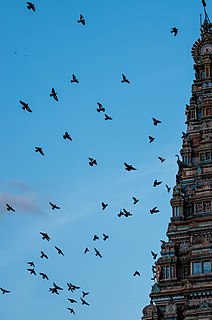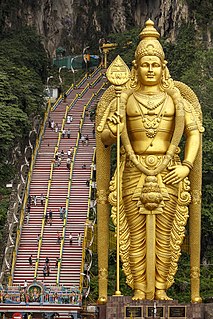
Tiruchendur Murugan Temple is an ancient Hindu temple dedicated to lord Murugan. It is second among six abodes of lord Murugan (Arupadaiveedugal) situated in Tamil Nadu, India. The puranic name or historical name for this temple is Jayanthipuram. This temple is the fourth Hindu temple in Tamil Nadu to get ISO certification. It is located in the eastern end of the town Thiruchendur in the district of Tuticorin, Tamil Nadu, India. It is 60 km south-east of Tirunelveli, 40 km from Tuticorin and 75 km north-east of Kanyakumari. The temple complex is on the shores of Bay of Bengal. Temple is open from 5 AM to 9 PM

Vaḷḷi is a Hindu goddess and the consort of the god Kartikeya. Valli is a tribal head girl, who lead a life as a huntress. Murugan the war god belongs to the mountain regions also known as Kurunji the same place where valli belongs.

Thiruporur is a panchayat town in Chengalpattu district in the Indian state of Tamil Nadu. The Thiruporur Kandaswamy temple is situated in the center of the town. There is a large temple tank in the vicinity of the temple. Thiruporur is located on Old Mahabalipuram Road and is flanked by Kelambakkam on one side and Alathur Pharmaceutical Industrial Estate on the other side, both of which are also on Old Mahabalipuram Road.

Kukke Subramanya is a Hindu temple located in the village Subramanya, of Kadaba taluk in Dakshina Kannada district Karnataka. In this temple Kartikeya is worshipped as Subramanya,lord of all serpents. The epics relate that the divine serpent Vasuki and other serpents found refuge under Subramanya when threatened by the Garuda.

Thiruparankundram Murugan Temple or Subramanya Swamy Temple is a Hindu temple and one of the Six Abodes of Murugan, located at Thiruparankundram. The temple is built in rock-cut architecture and believed to have been built by the Pandyas during the 6th century. According to the legend it is where Murugan slayed the demon Surapadman and married Deivayanai, the divine daughter of the king of heaven, Indra, and he is said to have worshipped Shiva here as Parangirinathar.

Swamimalai Swaminathaswamy Temple is a Hindu temple dedicated to god Murugan. It is located in Swamimalai, 5 km from Kumbakonam, on the banks of a tributary of river Kaveri in Thanjavur District, 250 km from Chennai, the capital of Tamil Nadu, India. The temple is second abode of Murugan among six (Arupadaiveedugal). The shrine of the presiding deity, Swaminathaswamy is located atop a 60 ft (18 m) hillock and the shrine of his mother Meenakshi (Parvathi) and father Shiva (Sundareswarar) is located downhill. The temple has three gopuram, three precincts and sixty steps and each one is named after the sixty Tamil years. The temple has six daily rituals at various times from 5:30 a.m. to 9 p.m., and three yearly festivals on its calendar. The annual Vaikasi Visagam festival is attended by thousands of devotees from far and near.

Arulmigu Dhandayuthapani Swami Temple is First of the Six Abodes of Murugan(Aarupadai veedugal). It is located in the city of Palani earlier it was known as 'Thiruavinangudi' ,Dindigul district, 150 kilometres (93 mi) southeast of Coimbatore and northwest of Madurai in the foothills of the Palani Hills, Tamil Nadu, India. Palani temple is considered synonymous with Panchamritam, a sweet mixture made of five ingredients.

Kumara Swamy Devasthana, is a Hindu temple located in Hanumanthanagar, in the city of Bangalore, Karnataka, southern India. It is dedicated to Lord Kumara Swamy, also known as Lord Subrahmanya or Murugan.

Kataragama deviyo is a guardian deity of Sri Lanka. A popular deity who is considered to be very powerful, shrines dedicated to Kataragama deviyo are found in many places of the country. Sinhalese Buddhists believe him also as a divine patron of the Buddha Sasana in Sri Lanka. An ancient temple dedicated to God Kataragama, known as Ruhunu Maha Kataragama Devalaya is situated in the South-Eastern town of Kataragama in Monaragala District of Uva Province.

The Ettampadai is a temple of Lord Murugan (Subrahmanya) in India, located in the neighbourhood of Triplicane (Thiruvallikkeni) in Chennai.
Kumarakoil or Kumarakovil is a small village in Kanyakumari district. Here is the famous Subrahmanya (Muruga) Temple by the name of Velimalai Kumaraswamy Temple. The temple was built on a hill named 'Velimalai'. The name "Veli" was named from the Malayalam word "veli" means marriage.It is the place where marriage of Murugan and Valli was done. Koravans used to come to the temple for marriage of Valli, since Valli Devi belongs to Koravan community. Lord Muruga and his consort Goddess Valli are the main deities. It is believed that they married here. It is built on a rocky terrain about 200 feet in height.

Devasena is a Hindu goddess and the first wife of the god Kartikeya. She is known as Devayanai, Deivanai or Deivayanai. in south-Indian texts. Her name is also spelled as Teyvanai or Tevayanai.

The Six Abodes of Murugan are six temples situated in the state of Tamil Nadu in South India. The god is known by different names such as Kartikeya, Kanda, Vadivela and Murugan at various temples. The six most sacred abodes of Murugan was mentioned in Tamil sangam literature, "Thirumurugatrupadai", written by Nakkeerar and in "Thiruppugazh", written by Arunagirinathar. The six abodes are Thiruparankundram, Tiruchendur, Palani, Swamimalai, Thiruthani and Pazhamudircholai.

Kartikeya, also known as Skanda, Kumara, Murugan and Subrahmanya, is the Hindu god of war. He is the son of Parvati and Shiva, brother of Ganesha, and a god whose life story has many versions in Hinduism. An important deity around South Asia since ancient times, Kartikeya is particularly popular and predominantly worshipped in South India, Sri Lanka, Singapore and Malaysia as Murugan.

Kundrathur Murugan Temple is a Hindu temple located in Kundrathur, a suburb of Chennai in the Kancheepuram district of Tamil Nadu.

Sooranporu or Soorasamharam part of Skanda Sashti Vratham festival is a ritual folk performance that recreates the killing of Asuras by Lord Murugan. It is performed in Tamil Nadu, Sri Lanka and the district of Palakkad in Kerala at temples dedicated to Murugan. The Soorasamharam festival is also celebrated in Thiruvannur Subramanya Swami temple in Kozhikode District kerala for more than a century in the name Sooranpada. The 2020 date is 20 November.

Pachaimalai Arulmigu Subramanyaswamy Temple is one of the two major hill temples located in Gobichettipalayam, Tamil Nadu, dedicated to Tamil God Murugan. The temple constructed in the Tamil style of architecture, is located on top of a small hillock in the outskirts of the town of Gobichettipalayam.

Arthanāreeswarā temple is an ancient Hindu temple, located in Tiruchengode, in the southern Indian state of Tamil Nadu. The temple is dedicated to Arthanāreeswarā, the unique half-male half-female of Lord Shiva. It is perhaps the only temple in Asia where this rare form of the Divine is enshrined as the principal deity. The deity here is also known as Mādhorubāgan and Ammaiyappan (mother-father). The famous Chenkottu Velavar Temple, dedicated to Lord Murugan, is also situated on the same hill.

Kanthaswamy Temple in Cheyyur, in Chengalpattu district in the South Indian state of Tamil Nadu, is dedicated to the Hindu god Murugan. Constructed in the Dravidian style of architecture, the temple was constructed during the Cholas during the 10th century. Muruga is worshipped as Kanthaswamy along with his consorts Valli and Deivasena. A granite wall surrounds the temple, enclosing all its shrines.

Thirumakaraleeswarar Temple is a Hindu temple dedicated to the deity Shiva, located in Magaral, a village in Kanchipuram district in the South Indian state of Tamil Nadu. Shiva is worshipped as Thirumakaraleeswarar, and is represented by the lingam. His consort Parvati is depicted as Tribuvananayagi. The presiding deity is revered in the 7th century Tamil Saiva canonical work, the Tevaram, written by Tamil saint poets known as the Nayanmars and classified as Paadal Petra Sthalam.


















